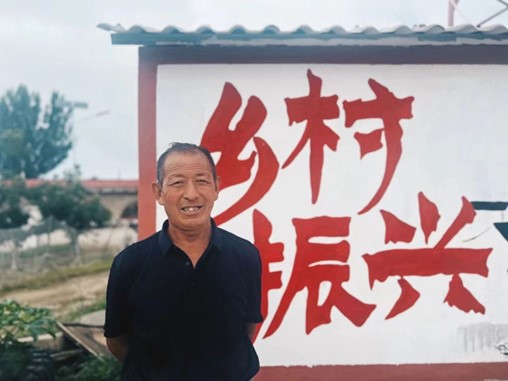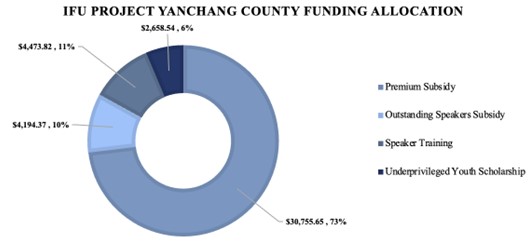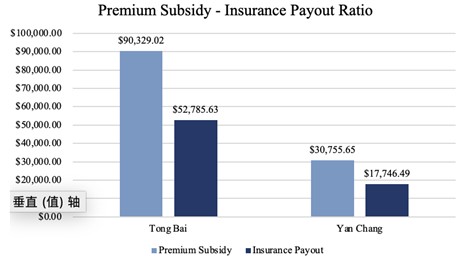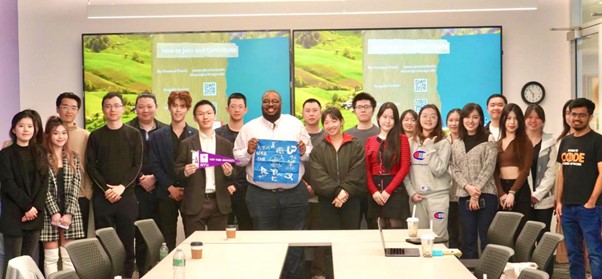“Bridging Gaps, Building Futures: US-China Collaboration on Rural Finance And Sustainability”
By: Grace Homan, Jiani He, Isabella Pezzulli
In the sprawling landscapes of Woodside, California, on November 15th of 2023, the fate of nations hung in the balance as President Biden and President Xi Jingping of the People’s Republic of China engaged in a pivotal summit. Despite the serene backdrop, the discussions were charged with the urgency of addressing a critical issue that transcends borders: rural finance and sustainability.
An American farmer struggles against financial adversity while grappling with the unpredictable repercussions of an ever-changing climate. At the same time, on the other side of the world, a farmer in the vast fields of China contends against the same challenges of the global climate crisis and price fluctuation. Despite their different language and culture, their shared dilemmas underscore the interconnectedness and mutual responsibility of global leaders to enact change in the realm of agriculture and sustainability.
The China-U.S. Summit sought to bridge gaps and foster collaboration between the two countries while also allowing for constructive discussion in areas of difference. Despite their history of competition, the two leaders agreed on the urgent need to tackle the pressing issues regarding agricultural sustainability. There is humility in the recognition that the climate crisis is not a hurdle that can be tackled alone; there is a need for a unified front that promotes rural economic resilience, thereby achieving sustainable development in the long run.
Constituting the world’s largest economies, the U.S. and China possess unparalleled resources to impact sustainability far into the future. By fostering a spirit of cooperation and shared commitment to the planet, there is insight to be gained from the policies, innovations, and experiences that can drive progress in the pursuit of a sustainable and economically resilient future, while also addressing poverty and enhancing risk management strategies.
Shared Struggles, Shared Solutions
In the United States, rural finance has been the cornerstone of agricultural development, supporting farmers and fostering economic growth in rural communities. This sector has a well-established system of agricultural loans, subsidies, and insurance programs designed to mitigate financial risks. However, despite this long-standing structure, many challenges persist and continue to worsen. For one, farmers face difficulties reaching financial institutions due to physical proximity and often lack the means to secure loans or financial support. Additionally, climate change exacerbates these challenges by increasing the frequency of extreme weather events, which can devastate crops and make it even harder for farmers to secure economic stability. Clearly, there is a pressing need to ensure that rural areas are not left behind as technology continues to reshape our financial landscape.
In China, rural finance has undergone major changes over the past few decades. For instance, the policies and financial reforms have been implemented in an effort to modernize agricultural divisions and provide farmers improved access to credit and financial services. According to data from the Financial Department of the Ministry of Finance of China, China’s agricultural insurance compensation paid out 112.4 billion yuan last year, a year-on-year increase of 25.4%, benefiting 57.72 million rural households, and the agricultural insurance compensation rate has reached 80%. However, despite these reforms, disparities persist between regions, with farmers struggling to secure adequate and reliable financing services. For example, the People’s Bank of China and the Ministry of Agriculture show that the growth rate of China’s inclusive small- and micro-loans has declined for three consecutive years since 2021, and the penetration rate of cash crop price insurance has not yet reached 50%. Thus, China’s challenge is to ensure that financial services reach all corners of this immense rural community.
Ultimately, the issues of poverty risk management and environmental sustainability are two sides of the same coin, with similar issues that pose both shared challenges and shared opportunities for the United States and China.
Comparative Insights: U.S. and China’s Rural Finance Strategies
In the United States, rural finance is managed through a system of agricultural loans and insurance programs. These include digital financial inclusion initiatives, Revenue Protection via crop insurance, and environmental sustainability efforts that encourage eco-friendly practices. However, the tech-driven financial inclusion approach in the U.S. faces challenges in ensuring equitable access, particularly in remote areas. Despite these hurdles, the U.S. has made significant strides in integrating technology into financial services, aiming to make them more accessible and efficient for rural communities. Both the USDA and the industry associations created high-quality tutorial videos and platforms for specific crop growers to learn how to apply for different programs, like the Agriculture Risk Coverage (ARC) and Price Loss Coverage (PLC). In addition, members of organizations like the U.S. Apple Association could easily access macro data like production, price trends, and import-export figures which help optimize their financial decisions.
China, on the other hand, approaches rural finance through robust policy support, inclusive finance measures, and extensive digital services. Revenue protection in China involves comprehensive agricultural insurance and disaster relief programs. Moreover, China’s poverty risk management strategy emphasizes infrastructure development, education, and sustainable development goals. The country has also implemented significant measures to address environmental issues, such as pollution control, clean energy adoption, and large-scale afforestation projects. Centralized planning allows for rapid and effective implementation of these initiatives, although regional disparities may often be overlooked.
Comparatively, the U.S. and China each exhibit distinct strengths and weaknesses in their approaches. The U.S. could benefit from China’s effective, large-scale initiatives and policy-driven support, while China could learn from the U.S.’s technical advancements in financial inclusion. Highly related to the financial market in the US while in China the central government takes the initiative, both two are comparatively fit the nation’s situations. By sharing insights and strategies, both nations can address their respective challenges more effectively, paving the way for a more resilient and sustainable future for their citizens.
Pioneering Financial Solutions for Farmers—IFU Project
In June 2022, the “Inclusive Finance for the Underrepresented Farmers” (IFU) project emerged under the guidance of the China Siyuan Foundation for Poverty Alleviation, a nationally recognized public fundraising foundation managed by the China National Democratic Construction Association (CNDCA), one of China’s prominent political parties. The IFU project’s mission is unequivocal: to empower underrepresented farmers, ensuring their economic resilience and sustainability through innovative financial solutions.
The IFU project is supported by a diverse and talented group of members, including students and faculty from prestigious institutions such as the University of California, Davis; University of California, Berkeley; Harvard University; Massachusetts Institute of Technology; Columbia University; University of Chicago; New York University; Georgetown University; Northeastern University, and others. Their commitment and collective expertise are instrumental in advancing the project’s mission and ensuring its success.
At the heart of the IFU project lies the innovative “From Zero to One” concept, revolutionizing the way farmers mitigate financial risks. By combining insurance with future trading, IFU empowers farmers to safeguard their livelihoods against market fluctuations. Farmers purchase price insurance for their agricultural products, ensuring that if market prices plummet, the insurance company compensates for losses.
The IFU project is not merely a financial endeavor; it represents a seismic shift in addressing rural poverty and financial insecurity in China. In regions where government support is insufficient or limited, the IFU initiative steps in and leverages donated funds to provide farm subsidies and revenue protection. This innovative approach replaces the absence of government aid with community-driven support, amplifying the impact of each donation. For instance, a donation equivalent to 14 USD could translate into safeguarding 124 USD worth of agricultural products for a farmer, underscoring the exponential effect of the initiative. In areas like Yanchang County, situated in Shaanxi Province, local traditions and influential community leaders often dictated agricultural practices, leaving many farmers vulnerable to financial instability. Here, the exponential effect of the IFU initiative was transformative.
Innovative Strategies and Achievements of IFU
In regions where traditional practices often clash with modern financial mechanisms, the IFU Project has emerged as a beacon of hope. Through targeted interventions and tailored financial solutions, the IFU has transformed the lives of hundreds of farmers, providing them with a safety net during times of uncertainty. The project has supported over 600 individuals, with total compensation payments amounting to approximately 71,706.18 USD, helping farmers cover losses from fluctuations in market prices. Additionally, part of the funding has been allocated to grassroots financial inclusion speakers, training, and scholarships. These efforts have secured an astonishing 2.8 million USD of agricultural income, stabilizing farmers’ earnings and mitigating financial risks. By partnering with prominent futures companies and focusing on innovative agricultural support, the IFU Project has demonstrated a strong commitment to financial resilience and sustainable development in rural communities.
Data visualisation plays a crucial role in illustrating the impact of IFU’s initiatives. Infographics depicting the efficacy of agricultural finance models not only inform but also inspire action, demonstrating the tangible difference that community-driven support can make in alleviating rural poverty.
The IFU ensures that no farmer is left behind, providing comprehensive support to small-scale agricultural producers. By targeting underrepresented groups, including female and marginalized communities, the IFU promotes inclusivity and equality in rural finance. Recognizing the importance of youth engagement in sustainable development, young people are incentivized to pursue studies in inclusive finance, fostering a new generation of change-makers. Supported by a team of international development experts, this ensures that aid delivery is efficient, transparent, and tailored to the unique needs of each community.
Michael Carter, who is a distinguished Professor of Agricultural and Resource Economics at UC Davis and a leading expert in development economics, demonstrates that micro interventions like index insurance subsidies, asset smoothing, and rural financial education would have a great impact on both inter and intra household poverty dynamics, just like the IFU did.
Expert insight sheds light on the transformative potential of community-driven initiatives like the IFU, underscoring the importance of collaborative efforts in addressing rural poverty and promoting sustainable development. As the reach and impact continues to expand, the project serves as a testament to the power of collective action in building a more resilient and equitable future for underrepresented farmers in China and beyond.
U.S.-China Collaboration: A Path to Global Sustainability
In both China and the United States, rural communities bear the brunt of climate change—facing extreme weather events, shifting agricultural patterns, and environmental degradation. Smallholder farmers are at unique risk to these changes as many of their livelihoods depend on the state of their land. Simultaneously, economic issues further heighten the risk of poverty, elevating this issue to the national and global scale. As a result, effective poverty risk management and strategies to increase environmental sustainability are critical.
Fortunately, cooperation between the United States and China in the face of these mutual challenges presents a valuable opportunity for mutual learning and long-lasting impact. The United States can draw inspiration from China’s successes in rural finance transformation and China can learn from the United States’ innovative approaches to sustainability. By fostering collaboration, these two countries can pave the way for a more sustainable and economically just future, transcending borders and acting as an example of global cooperation to tackle shared challenges for the greater good.
Mr. Zhiyao Ma, the Executive Director of the IFU project, envisions a transformative future: “If China and the United States collaborate for another 50 years to advance rural agriculture and capital-accessibility for small farmers, we could significantly mitigate global hunger and inequality. Such an achievement would be a monumental milestone in the annals of human history.”
The IFU Project has successfully concluded its “Insurance + Futures” Price Insurance Project in partnership with the aforementioned Yanchang County Government for local apple orchards. This initiative provided essential support to 400 individuals, covering a total of 177.39 acres, with compensation payments amounting to approximately 17,746.49 USD. Each ton of apples received 20.07 USD in compensation, and each acre was compensated with 100.04 USD.
The total funding for the IFU Project in Yanchang County was 42,211.38 USD. Of this, 30,755.65 USD was allocated to directly subsidize agricultural product price insurance premiums for struggling farmers as part of the “Insurance + Futures” incentives. Additionally, 4,194.37 USD was dedicated to subsidizing outstanding grassroots financial inclusion speakers, 4,473.82 USD was used for training grassroots “Insurance + Futures” speakers, and 2,658.54 USD was allocated for financial inclusion scholarships for underprivileged youth. These additional funds were generously provided by Changjiang Futures Co., Ltd.
Figure 1: IFU Project Yanchang County Funding Allocation
Meanwhile, under the official authorization of the Tongbai County Government, the IFU Project collaborated with five Fortune 500 futures companies—COFCO Futures Co., Ltd., China Futures Co., Ltd., China Merchants Futures Co., Ltd., Huatai Futures Co., Ltd., and Huaan Futures Co., Ltd. In addition, the introduction of the Shenzhen Yuze Foundation and the Shenzhen Kaifeng Foundation brings a synergy of national-, regional- and corporate-level charity funds. Together, they developed an innovative agricultural support model that combines “insurance + futures + multi-level public welfare fund.” This collaboration resulted in the 2023 Tongbai County Peanut Price Insurance Project, aimed at assisting poverty alleviation for households engaged in peanut cultivation. As two core members of the IFU projects, Li Runlu and Zhang Chang, point out, “the project aimed to stabilize income for peanut farmers by providing price insurance, thereby mitigating financial risks associated with price fluctuations.”
Figure 2: Per Acre Premium Subsidy – Insurance Payout Ratio
As of May, the IFU Project in Tongbai County has officially concluded, with all compensation payments finalized, amounting to approximately 52,785.63 USD, reflecting a payout rate of 43.95%. On average, each acre received a compensation of 8.45 USD, covering a total of 6,246.82 acres.
Figure 3: Premium Subsidy – Insurance Payout Ratio
By integrating modern financial mechanisms with traditional agricultural practices, the IFU Project has demonstrated a strong commitment to financial resilience and sustainable development in rural communities.
Over the next five years, the IFU project aims to raise $1 million in donations from various sectors of society. This funding will support 10,000 struggling farming households in developing countries, helping them break the cycle of poverty and mitigate production and market risks through inclusive financial instruments such as agricultural insurance, futures, and credit. Additionally, the project will provide scholarships and host international workshops to cultivate 100 young practitioners and academic experts, fostering global awareness and action on this critical yet often overlooked issue.
Conclusion:
The success of the IFU Project exemplifies the profound impact of combining modern financial mechanisms with traditional agricultural practices. By providing essential financial support and fostering innovative agricultural models, the project has stabilized farmer income and mitigated financial risks associated with market fluctuations. The generous contributions from Fortune 500 companies emphasize the importance of public-private partnerships in driving sustainable development. These efforts ensure that the benefits of financial inclusion reach the most vulnerable of farmers.
As the IFU Project continues to evolve, its approach serves as a blueprint for future initiatives aimed at addressing rural poverty and environmental sustainability. The IFU Project can help serve as a bridge for U.S.-China communication and collaboration, and as a tool for sustainability cooperation and rural finance development. Such a partnership can significantly contribute to achieving the United Nations’ Sustainable Development Goals (SDGs) and advancing Environmental, Social, and Governance (ESG) standards. The IFU welcome U.S. companies and donors to support the project, encouraging a spirit of collaboration and leveraging each other’s strengths to promote global sustainability and economic resilience for the future.
For further information, please visit our official website at ifuimpact.org.
For inquiries, you can contact us via email at ifu_office@sygoc.org.cn.

















